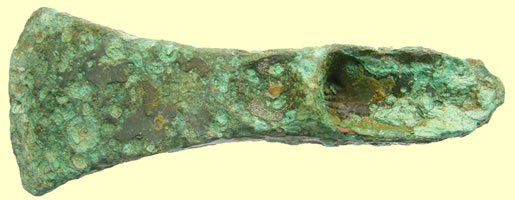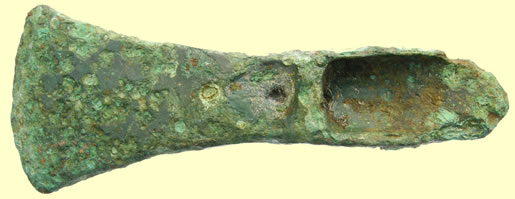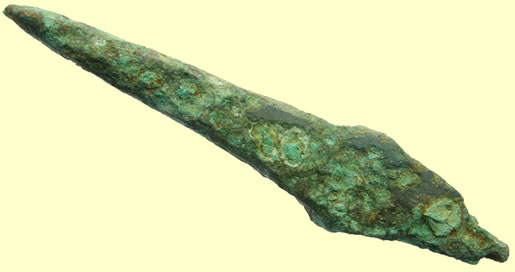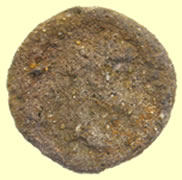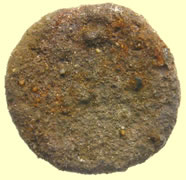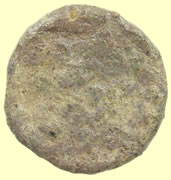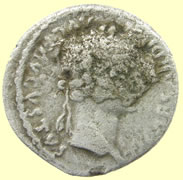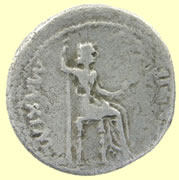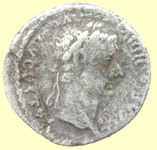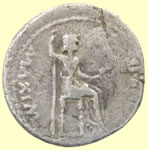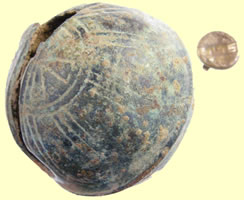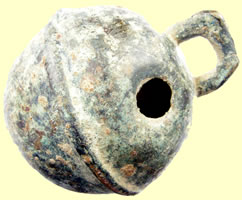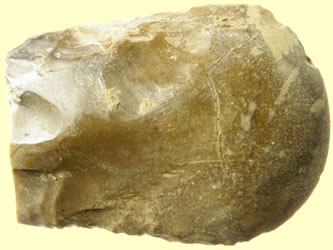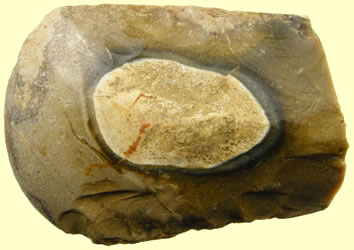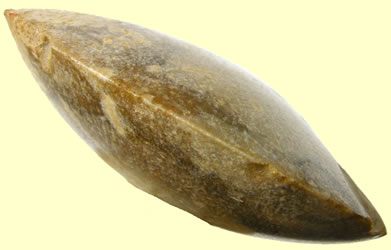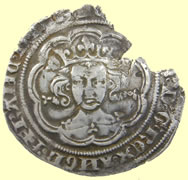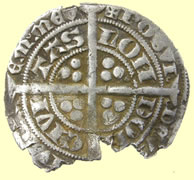

Metal detecting holidays in England with the World's most successful metal detecting club.
Twinned with Midwest Historical Research Society USA
Sept 2008 finds page 1 |
|||||||||||||||
 |
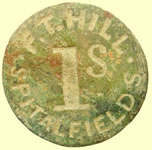 |
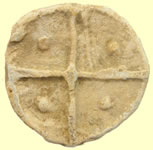 |
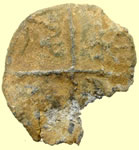 |
||||||||||||
19thC Livery button
|
19thC 1 shilling Spittalfields Market token - P.T.Hill |
15thC lead token - long cross and pellet type |
Very unusual 15thC lead token with Lombardric writing in the quadrants - needs more research |
||||||||||||
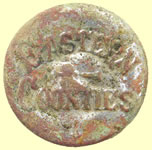 |
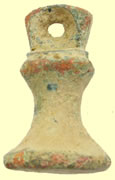 |
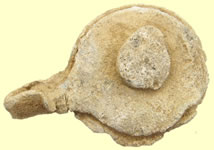 |
 |
||||||||||||
20thC Eastern Counties bus button |
Georgian bell type trade weight - hallmarked Crown G |
Post mdedieval cloth seal |
Miltary badge ? Honi soit qui mal y pense (Old French: shame upon him who thinks evil of it) CSA ?? Needs reserching |
||||||||||||
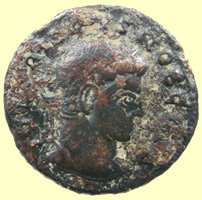  |
|||||||||||||||
No gold in this issue - the Romans may have used copper to debase gold (although, interestingly, unlike with the silver, they tended not to do this very much and instead struck smaller rather than debased gold coins in times of economic emergency) It certainly would have been "silvered", however - when new it would have had a wash of shiny white metal over the surface - this coating didn't last long and finding specimens of this era with any more than a trace of their silvering intact is very unusual.
This is "The Unfortunate Crispus", as history tends to style him. This eldest son of Constantine the Great by his 1st wife (before he was forced, for political reasons, to divorce her and marry Maximian's daughter) Crispus was having a brilliant career as a soldier and was extremely popular with the people. Constantine's 2nd wife (as the story goes) mother of the future emperors Constantine II, Constans and Constantius II, plotted to get rid of Crispus to clear the way for one or more of her sons to succeed Constantine. After she connived in concocting a story of rape and treason against Crispus, Constantine had him excecuted (there's some question here whether Crispus' popularity and military successes might not have been at least part of the great pragmatist, Constantine's, decision to do away with his own son).
Later, when Fausta's complicity in the plot was exposed, he had her sealed in a bath with a hypocaust beneath it, then had the fire stoked until she was boiled to death like a lobster.
This piece, from the Vota series, was struck at Siscia in 320 AD. The legends are thus:
Obv: IVL CRISPVS NOB CAES Laureate head right
Rx: CAESARVM NOSTRORVM around wreath, VOT / V within; GSIS (Siscia, 3rd officina) in exergue. RIC VII 151.
The "VOT V" is in proclamation of Crispus' undertaking the vows of his 5th year as a Caesar. The Emperor as Pontifex Maximus and "heirs apparent" Caesars as high priests of the State religion (despite Constantine and his family's official recognition of Christianity) undertook vows to perform certain ceremonies and sacrifices at various intervals (usually every 5 and/or 10 years) as sort of a bargain with the gods - "I'll faithfuly attend to doing these sacrifices for you if you'll keep me alive and in power for another 5 (or 10) years." Often appearing on reverses as merely VOT / V / MVLT / X (or X & XX, or XX & XXX, etc) within a wreath, this one honors the 3 Caesars created simultaneously 5 yrs before, Crispus, Constantine II, and Licinius II.
Mark |
|||||||||||||||
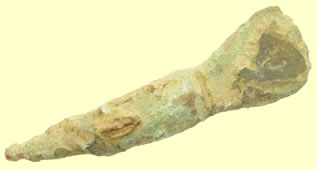 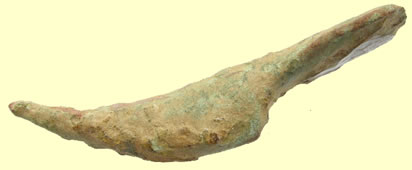 |
|||||||||||||||
Roman bronze artefact - Looks like this is the bow part of a fibular brooch but I think it is a small Roman votive offering pot leg - researching it more |
|||||||||||||||
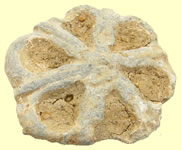 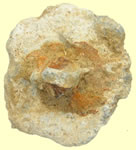 |
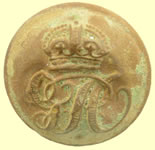 |
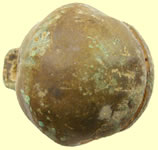 |
|||||||||||||
Medieval lead petal mount |
George Rex button |
18thC crotal bell with foundry mark |
|||||||||||||
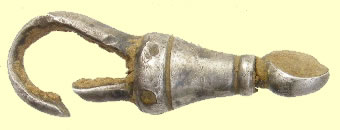 |
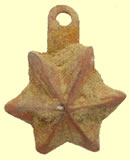 |
 |
|||||||||||||
19thC silver clasp |
Georgian harness pendant |
Military button - not check ref books yet |
|||||||||||||
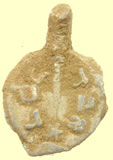 |
 |
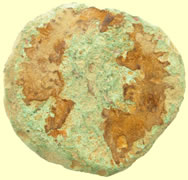 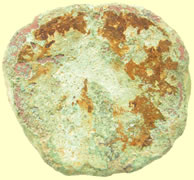 |
|||||||||||||
| Post medieval alnage cloth seal | Silver overlaid Life guards button ?? |
Roman 1st C bronze sent off for ID 21.64g, 33.15mm From the size and weight, it's a sestertius. From the outline and what I think I make of the letter-seriphs, it's Antoninus Pius. I can't really say much more about it with no reverse visible and none of the obverse legend clearly readable.
Mark
|
|||||||||||||
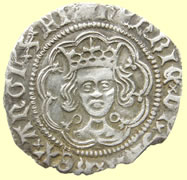 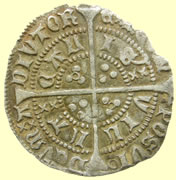 |
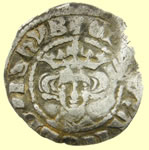 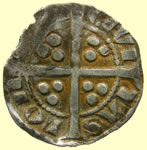 |
||||||||||||||
Henry VI 1422-27 Hammered silver half groat - Calais mint - Annulet issue - annulets by neck and between two sets of opposing pellets 21.18mm, 1.79g |
Edward III 1344-51 hammered silver florin penny Obv EDWAR ANGL DNS HYB Rev CIVI/TAS/LON/DON - London mint 1.28g, 17.84g |
||||||||||||||
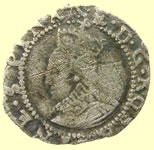 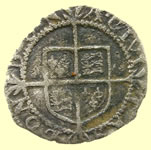 |
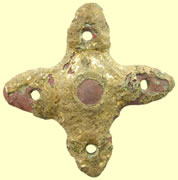 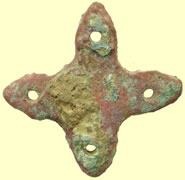 |
||||||||||||||
1582-4 Elizabeth 1st hammered silver penny - A mintmark 6th issue |
Circa 10thC Saxon gilded mount with 4 rivet fixing 9.76g, 34.49mm x 5.38mm T |
||||||||||||||
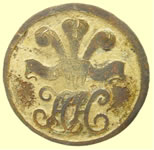 |
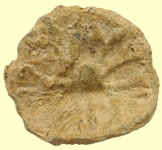 |
 |
 |
||||||||||||
Prince of Wales feathers military button Not checked the ref books yet |
15th C lead token - petal type | Really neat 19thC copper bare nuckle boxing statue |
One piece Navy button HONI SOIT QUI MAN Y PENSE PACKET Honi soit qui mal y pense (Old French: shame upon him who thinks evil of it) RN - Packet Service c.1800-1811 |
||||||||||||
 |
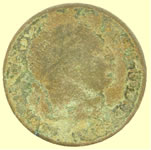 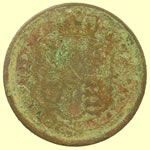 |
||||||||||||||
Military button - not check ref books yet |
1816 George III silver shilling forgery |
||||||||||||||
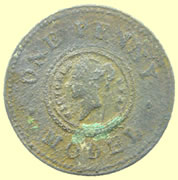 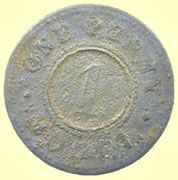 |
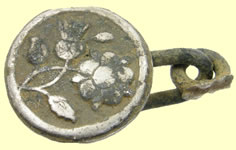 |
||||||||||||||
Never seen one of these Victorian 'model' one pennies, neat find 'They were a suggested design by Joseph Moore and made in either 1844 or 1848 to replace the heavy coinage then in circulation. According to Peck, the inner part was supposed to be in silver to compensate for the small intrinsic copper value but those produced in the greatest numbers had a copper outer ring and an inner part made of approximately 60% zinc / 40% nickel according to Freeman who analysed the metal composition of many coins. They were never adopted ' |
19thC silver cufflink |
||||||||||||||
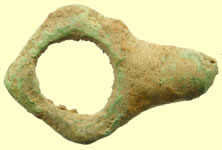 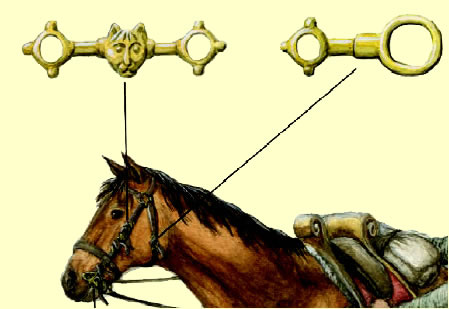 |
|||||||||||||||
Circa 10th C Saxon bridal cheek piece fragment |
|||||||||||||||
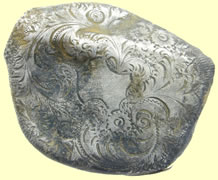 |
 |
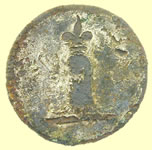 |
|||||||||||||
19thC Victorian silver watch back |
Army lapel badge |
19thC livery button |
|||||||||||||
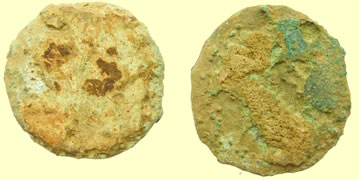 |
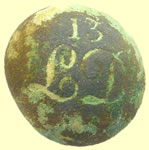 |
||||||||||||||
Huge Roman 'grots' |
This our 2nd 13th Light dragoons unlisted button - pre 1800
'Still unrecorded, but I have it in my book as the below' 13th Light Dragoons |
||||||||||||||
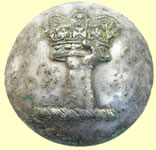 |
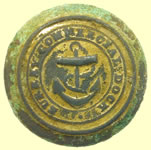 |
 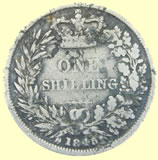 |
|||||||||||||
19thC livery button BM - W. Bowler Superior quality Not in ref books |
Surrey commercial docks |
1845 Victorian milled silver shilling |
|||||||||||||
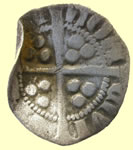 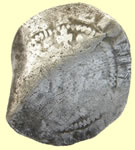 |
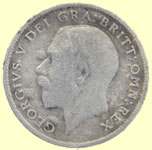 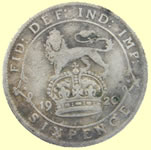 |
||||||||||||||
Edward III 1344-51 hammered silver florin penny Obv EDWAR ANGL DNS HYB Rev CIVI/TAS/LON/DON - London mint 16.74mm, 0.99g |
1920 George V milled silver sixpence (2) |
||||||||||||||
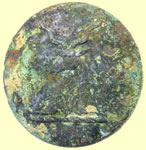 |
 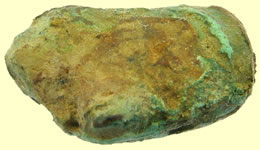 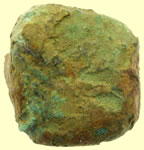 |
||||||||||||||
19thC livery button - stags head |
Roman bronze knife pommel - some of the iron tang remains |
||||||||||||||
  |
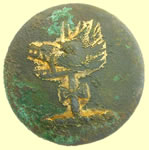 |
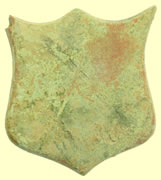 |
|||||||||||||
Huge medieval bronze pot leg |
19thC livery button Jennings and Co London 1832-1912 |
Georgian harness shield mount |
|||||||||||||
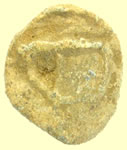 |
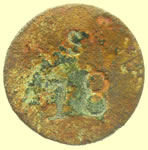 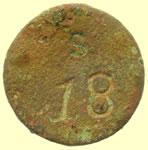 |
||||||||||||||
| Roman lead trade token |
1770's pattern 18 shilling coin weight - S18 |
||||||||||||||
  |
|||||||||||||||
1560 Elizabeth 1st hammered silver 3 pence |
|||||||||||||||
|
|||||||||||||||
1500 BC Middle Bronze age Falstave axe 134.9mm L x 58.34mm W, 330g |
|||||||||||||||
As dug
Cooked
|
 |
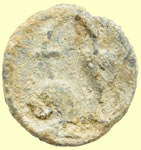 |
|||||||||||||
Early Roman silver coin in the 'cooker' to remove the horn silver crust 17.87mm, 3.01g This is a Tiberius Denarius of the so-called "Tribute Penny" type - reverse is Livia (his mother, the presumed poisoner of many of the Julio-Claudians) seated right. This was virtually the only type of denarius issued by Tiberius over his long reign from 14-37 AD. You have had at least one specimen of this type before, about which I wrote at some length if I recall correctly, so I would refer you to my earlier description and explanation of the type.
Mark
|
16th C Elizabeth 1st prohibited lead tavern pieces - glass and bottle |
16th C Elizabeth 1st prohibited lead tavern pieces - bottle flowing into glass |
|||||||||||||
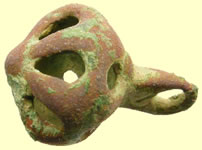 |
 |
 |
|||||||||||||
16thC Tudor fretwork button |
17thC hooked mount |
17thC nipple button |
|||||||||||||
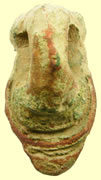  |
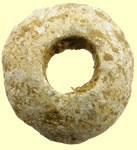 |
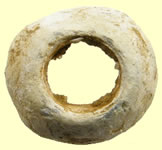 |
|||||||||||||
Facinating Roman brooch find - It is a trumpet brooch style on a plate brooch fitting - not in any ref books so one for the museum 13.74g, 31.75 H x 16.79mm W |
Roman lead domed top spindle whorl |
Medieval lead spindle whorl |
|||||||||||||
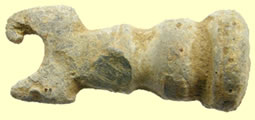 |
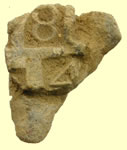 |
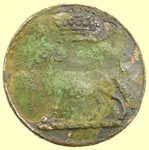 |
|||||||||||||
No idea yet what this lead object is but from a Roman area |
Post medieval lead cloth seal |
19thC livery button |
|||||||||||||
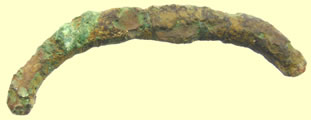 |
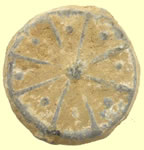 |
 |
|||||||||||||
Roman open looped dolphin buckle fragment |
17thC lead token |
17thC lead token |
|||||||||||||
 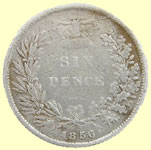 |
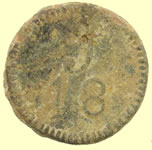 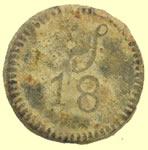 |
||||||||||||||
1856 Victorian milled silver six pence |
1770's pattern 18 shilling coin weight - S18 |
||||||||||||||
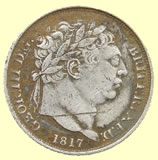 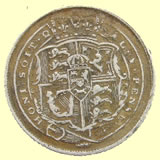 |
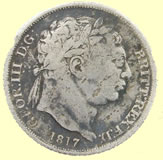 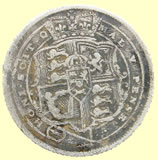 |
||||||||||||||
1817 George 1st milled silver six pence (4) |
1817 George 1st milled silver six pence (5) |
||||||||||||||
 |
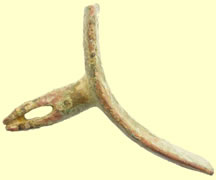 |
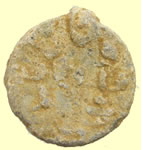 |
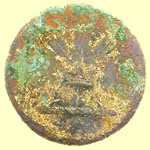 |
||||||||||||
17thC lead token |
17thC spur |
Post medieval cloth seal |
19thC livery button |
||||||||||||
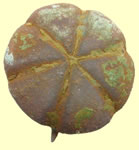 |
 |
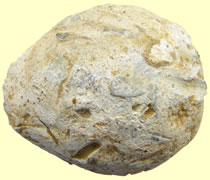 |
|||||||||||||
17thC petal mount with single integral lug |
Victorian Gold jewelry clasp (Reading's patent) |
18thC lead sewing egg |
|||||||||||||
 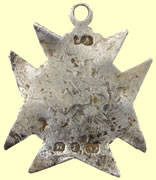 |
|
||||||||||||||
Victorian silver pendant Birmingham 1898 hallmark |
Huge decorated 18thC Crotal bell next to the gold clasp for size |
||||||||||||||
|
|||||||||||||||
3500 BC Neolithic flint axe 78.52mm L x56.74 mm L |
|||||||||||||||
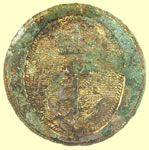 |
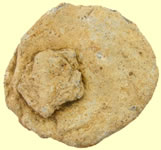 |
 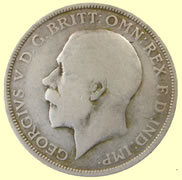 |
|||||||||||||
RN Capt / Commander - 1812 |
Post medieval plain lead cloth seal | 1920 George V milled silver florin (24 pence) (6) |
|||||||||||||
 |
 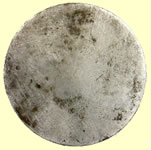 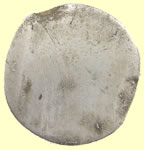 |
||||||||||||||
1943 George VI milled silver shilling (12 pence) |
3 slick 'willys' 1696 William III worn milled silver sixpences (10) |
||||||||||||||
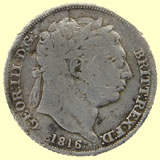  |
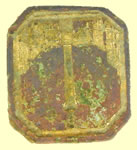 |
||||||||||||||
1817 George 1st milled silver shilling (11) |
Georgian giled cuff link |
||||||||||||||
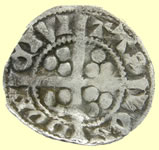 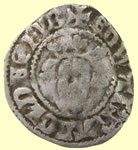 |
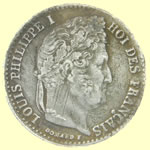 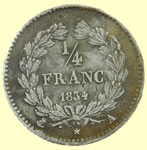 |
||||||||||||||
Edward III 1344-51 hammered silver florin penny Obv EDWARR ANGL DNS HYB Rev CIVI/TAS/LON/DON - London mint 1.30g, 18.0 mm |
1834 French Philippe I milled silver 1/4 franc |
||||||||||||||
 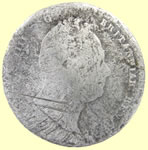 |
  |
||||||||||||||
1836 William IV milled silver shilling |
1922 George V milled silver sixpence |
||||||||||||||
 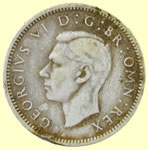 |
  |
||||||||||||||
1945 George V milled silver six pence (14) |
1634 Charles 1st hammered silver half groat ( 2 pence) |
||||||||||||||
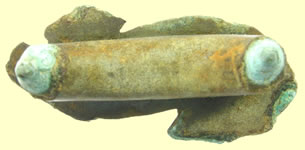 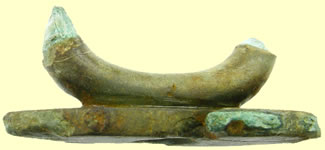 |
|||||||||||||||
Very unusual style Romano/British loop terret 12.08g, 35.06mm L x 15.25mm W - One for the museum to look at further
'Protected loop terrets are usually considered to be Roman and dating to the late first and second centuries AD'
|
|||||||||||||||
1351-2 Edward III hammered silver groat - Series C, mint mark cross 1, Letters C & E closed - Lombardic M obv E ***** DG.REX.ANGL.FRANC.**** Rev CIVI/TAS/LON/DON - London mint 27.7mm, 4.08g |
|||||||||||||||
 |
 |
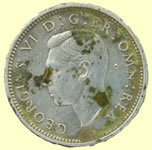  |
|||||||||||||
1876-1894 Honour; if the head of a "blackamoor" or Moor, refers to deeds of prowess in the Crusades Livery button Firmin & Sons Ld |
1938 George V milled silver sixpence |
||||||||||||||
 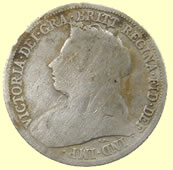 |
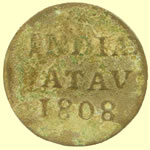 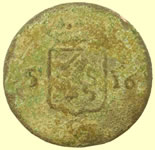 |
||||||||||||||
1894 Victorian milled silver 3 pence (17) |
1808 Dutch provences 1/16th of a skilling |
||||||||||||||
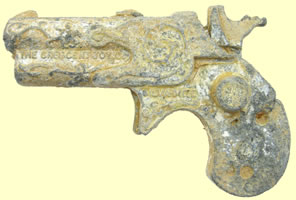 |
 |
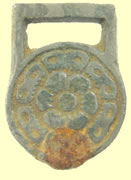 |
|||||||||||||
Toy pistol - shame it was not a real one |
17thC lead token |
17thC hooked clothing fastener |
|||||||||||||
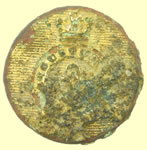 |
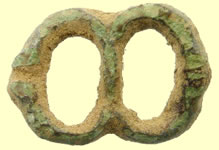 |
 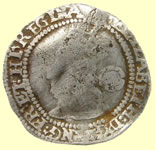 |
|||||||||||||
Navy button - not checkec ref books yet |
1550-1650 buckle |
1572 Elizabeth 1st hammered silver 3 pence - Ermine mint mark 4th issue | |||||||||||||
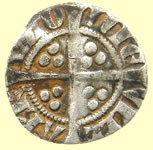 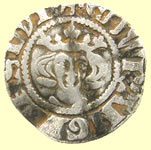 |
  |
||||||||||||||
1247 AD Henry III hammered silver voided long cross penny 17.71mm, 1.32g Unrecorded bust type similar to Class 1b- no mitre double pellet beard -cresent initial mark Obv LIE/TER/C(I:/LVN -London |
1218 Henry III hammered silver short cross penny, Class 7a 17.18mm, 1.25g, obv HENRI ON CANTE (Henri- Cantebury mint) |
||||||||||||||
 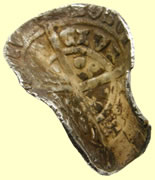 |
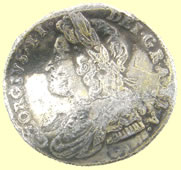 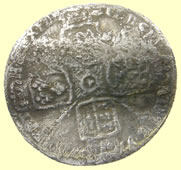 |
||||||||||||||
1472 Edward IV hammered silver groat Type 10 , initial mark sun both sides, trefoils by neck, long cross fitchee obv EDWARD DIA.REX.ANGL.Z.FRANC Rev CIVI/TAS/LON/DON - London mint 25.18mm, 2.79g |
1727 George II milled silver 6 pence love token (18) |
||||||||||||||
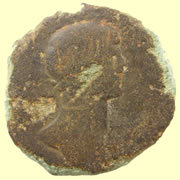 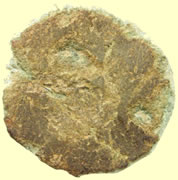 |
 |
||||||||||||||
Huge Roman bronze, just sent it off for ID 32.57mm, 14.43g It's smallish, weight-wise, for this, but the diameter is in the right range for it - I'm pretty sure it's a Sestertius of Trajan.
Or, let me put it this way - I'm sure it's Trajan (98-117 AD), but there is some room for questioning the denomination, since as a Sestertius it should weigh in the vicinity of 20+gm.
14gm is a bit on the heavy side (but not completely out of the question) for an As or Dupondius, but the diameter is really too large for either. Also, on a Dupondius the bust would have a radiate crown - this specimen has a laurel-wreath. Asses tend to be a bit lighter than Dupondii, hence it's even less likely to be an As, but it "works" best as a lightweight Sestertius.
Mark
|
Medieval strap end with 2 rivet fixings |
||||||||||||||
 |
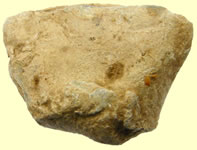 |
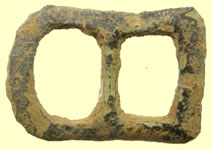 |
|||||||||||||
Military bale seal ? |
1640's Gun powder measure and cap |
1550-1650 buckle |
|||||||||||||
 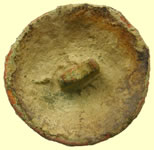 |
 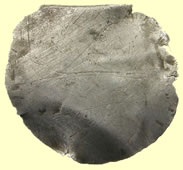 |
||||||||||||||
17thC button |
1554 Mary hammered silver groat |
||||||||||||||
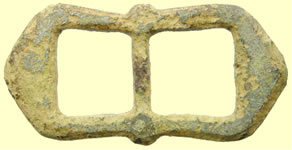 |
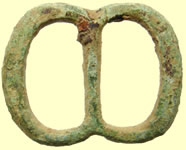 |
||||||||||||||
1550-1650 buckle |
Cast copper alloy double loop oval buckle
c1500 -1650 |
||||||||||||||
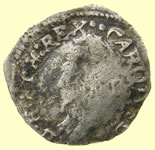 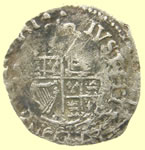 |
 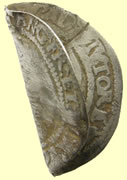 |
||||||||||||||
1641-3 Charles 1st hammered silver penny - mintmark 2 dots 'triangle and circle' King had left London and Parliament stuck these coins |
1570 Elizabeth 1st hammered silver 6 pence - castle mint mark |
||||||||||||||
 |
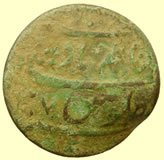 |
|
|||||||||||||
Roman harness ring |
19thC Mogul copper coin |
Interesting clay pipe stem with writing |
|||||||||||||
 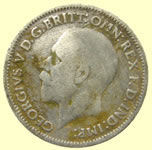 |
 |
 |
|||||||||||||
1932 George V milled silver sixpence (19) |
17thC lead token - rider on horse |
Georgian watch winder |
|||||||||||||
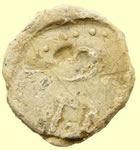 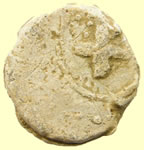 |
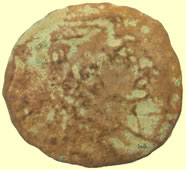 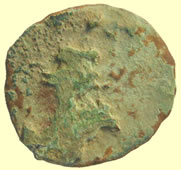 |
||||||||||||||
Interesting post medieval lead bale seal with cross impression |
Roman copper coin with good bust outline- 4.78g,25.46mm Sent for ID The size indicates an As or a Dupondius - a Dupondius, however, like a Sestertius, would have been made of "orichalcum" - a naturally-occuring and not-necessarily consistent form of brass. The Romans did not recognize zinc as a separate metal and lacked the technology necessary to make brass from elemental copper and zinc in controlled proportions even if they had been aware of zinc. Orichalcum, like brass in general, tends to do better under wet and otherwise corrosive conditions than copper. Asses, however, were made from nearly pure copper. The weight of this specimen is way outside of the standard deviation - way too light even for the underweight local copies of Imperial Roman coins. It has obviously lost in the vicinity of half of its original weight to corrosion and/or mineral leaching.
I can't be certain whether it was originally an officially issued, or a contemporary copy of an Imperial As, but the portrait seems to be of Antoninus Pius. I doubt it could be anyone else, since his short beard can appear like a bare chin. Imperial beards came into style with Hadrian and all emperors after that time were bearded, right up through the time that copper Asses became very scarce and went out of use in the early-mid 3rd century - usually all had beards long enough not to be mistaken for a bare chin but Pius is shown with his beard very short. The shape of the head is just not right for Trajan or any of the Flavians, nor is the style right for any of the clean-shaven Julio-Claudians.
Mark
|
||||||||||||||
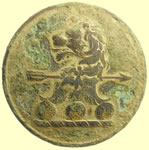 |
 |
  |
|||||||||||||
19thC livery button |
1696 William III milld silver sixpence (20) |
16th C Elizabeth hammered silver groat |
|||||||||||||
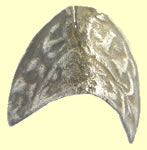 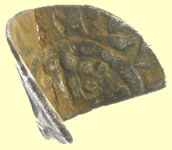 |
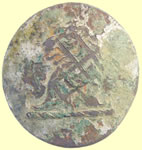 |
 |
|||||||||||||
1217 Henry III hammered silver short cross 1/2 penny - class 6b2 Moneyer Pieres of London |
19thC livery button |
19thC hunting button |
|||||||||||||
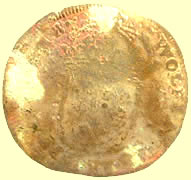 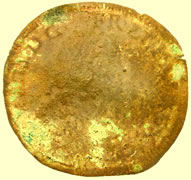 |
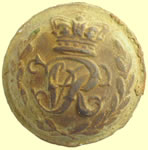 |
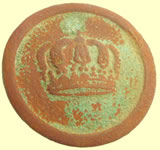 |
|||||||||||||
Wolf Lauffer II 1612-1651 German Jetton master This Jetton is dated to 1640 Diademed bust of Louis XIV right - LVS.XIIII.D.G:FR.ET.NAV:REX Rev Crowned French shield (bearing 3 Lis)WOLF LAVFER RECHPF: MACH IN N:B |
Military button - not checked ref books yet |
1880 pattern Prussian Army button |
|||||||||||||
 |
 |
 |
 |
||||||||||||
Army lapel badge |
18thC Royal navy button |
Post medieval lead prism standing weight |
Post medieval gaming counter |
||||||||||||
 |
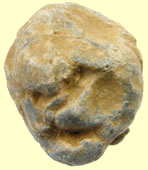 |
 |
|||||||||||||
18thc lead sewing palm guard |
Medieval lead face mount |
Medieval lead gamming token |
|||||||||||||
 |
 |
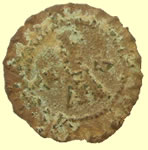 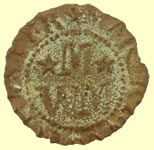 |
|||||||||||||
Georgian lead tobacco jar lid handle |
Life Guards regiment pre 1902 |
17thC hammered copper trade farthing - William Moore bays maker of Colchester Essex, Ref Norweb 1202a |
|||||||||||||
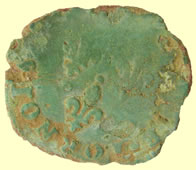 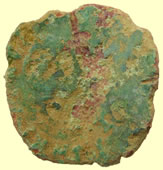 |
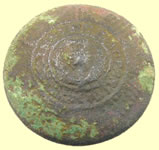 |
 |
|||||||||||||
| 16thC French Jetton with 3 Fleur de Lis - not checked ref books yet | Scottish regiment button with thistle- not checked ref books yet |
C10th C Saxon bridal cheek piece fragment |
|||||||||||||
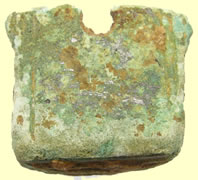 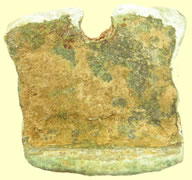 |
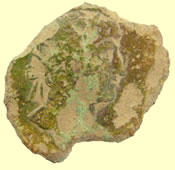 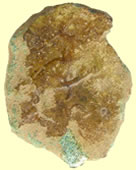 |
||||||||||||||
Interesting Roman period decorated stirrup looking plate - traces of silver gilding remains- one for the museum |
Roman bronze sent for ID - 25.23mm, 5.48g Another damaged, fragmentary and probably mineral-leached As. This one appears to be Antoninus Pius again- 138-161 AD - and the reverse has a standing figure, if you know which way to align it. I believe the standing figure of which we see the middle of the torso is Antoninus himself, togate, and sacrificing over an altar which is not quite visible to the left of the "S" from the S - C in the fields.
If it's the type I think it is, it dates to 148 AD.
|
||||||||||||||
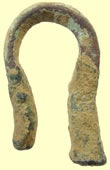 |
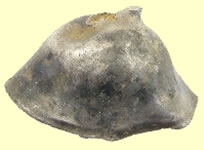 |
 |
|||||||||||||
Roman harness loop |
Medieval silver hawking bell fragment - reported as treasure to the museum |
Interesting 18thC spur with no spick or wheel type rowel |
|||||||||||||
 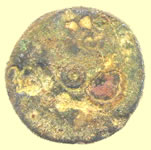 |
 |
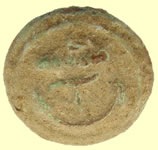 |
|||||||||||||
Georgian coin weight - Crown G London hallmark |
18thC Casket key fragment |
20thC Generic Merchant navy button |
|||||||||||||
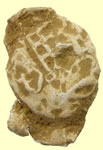 |
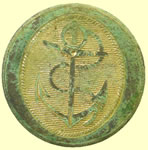 |
 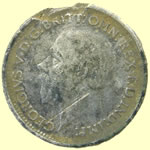 |
|||||||||||||
Post medieval lead cloth seal with portcullis impression- probably 16thC Tudor |
RN Capt / Commander - 1787 RN Lieutenant - 1787 |
1928 George V milled silver sixpence (21) |
|||||||||||||
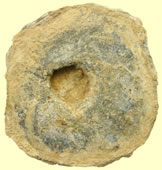 |
 |
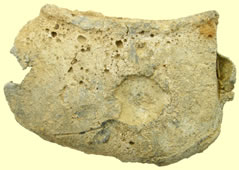 |
|||||||||||||
18thC lead sewing palm guard |
17thC nipple button |
18thC lead sewing palm guard |
|||||||||||||
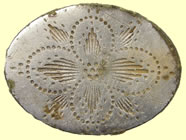 |
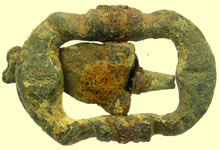 |
 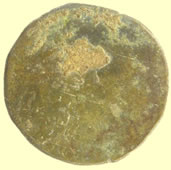 |
|||||||||||||
Silver plated Georgian cufflink |
1550-1650 spur buckle |
Fascinating hammered copper coin - not English - needs research |
|||||||||||||
 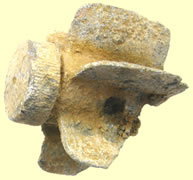 |
 |
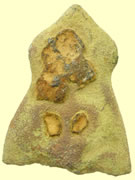 |
|||||||||||||
WWII bomb fragment ?? |
18thC clog fastener |
Medieval strap end with 3 rivet fixings |
|||||||||||||
 |
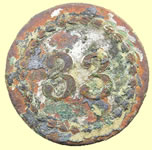 |
 |
|||||||||||||
18thC crotal bell with 'I' Foundry mark |
Superb find, American Rev Wars period 33rd Regiment of foot button - Officers |
Neat relic, 18thC musket ramrod guide |
|||||||||||||
 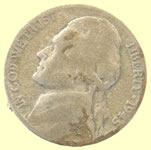 |
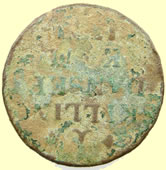 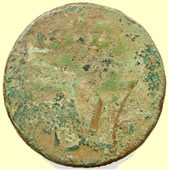 |
||||||||||||||
1945 American silver coin |
1771 Dutch copper coin |
||||||||||||||
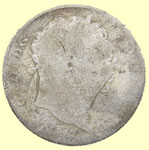 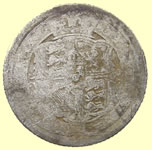 |
 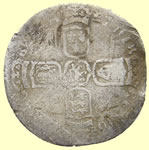 |
||||||||||||||
1817 George III milled silver sixpence (23) |
1696 William III milled silver six pence (24) |
||||||||||||||
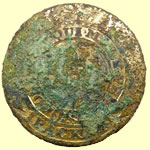 |
 |
 |
|||||||||||||
One piece Navy button HONI SOIT QUI MAN Y PENSE PACKET Honi soit qui mal y pense (Old French: shame upon him who thinks evil of it) RN - Packet Service |
19thC Copper alloy spur design brooch |
I thought this was turn of the century in date but looking at it closely I am not so sure- one for the museum to look at |
|||||||||||||
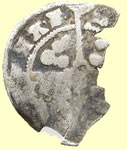 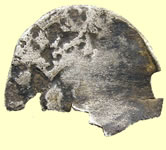 |
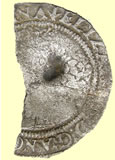 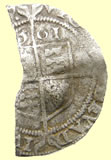 |
||||||||||||||
Medieval hammered silver penny |
1561 Elizabeth 1st hammered silver three pence - Pheon mintmark |
||||||||||||||
 |
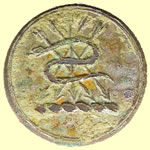 |
 |
|||||||||||||
17thC copper alloy mount |
19thC livery button |
1822 Swedish copper coin |
|||||||||||||
 |
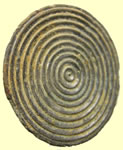 |
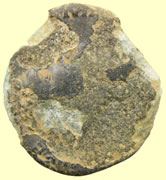  |
|||||||||||||
Georgian button |
Georgian spiral button |
Large Roman bronze sent for ID - not sure if there is enough detail left to make a guess as to it's date |
|||||||||||||
 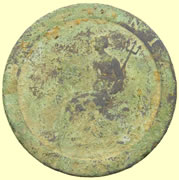 |
 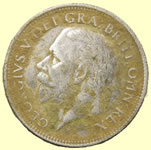 |
||||||||||||||
1797 George III cartwheel penny |
1929 George V milled silver shilling (25) |
||||||||||||||
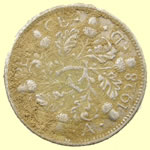 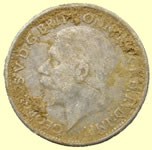 |
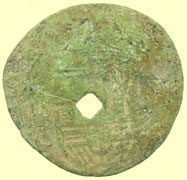 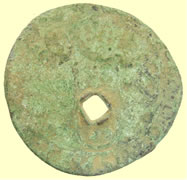 |
||||||||||||||
1928 George V milled silver sixpence (26) |
17thC dated jetton 16 ?? , 2.37g, 24.67mm - not checked ref books yet |
||||||||||||||
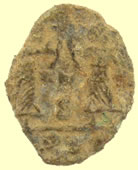  |
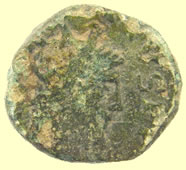 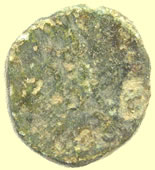 |
||||||||||||||
Roman bronze coin send for ID 0.89g,13.97mm |
Roman bronze coin sent for ID 16.78mm dia, 4.48g, 3.2mm Thick This could be a coin weight as it is very thick |
||||||||||||||
 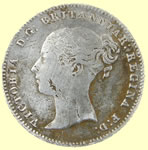 |
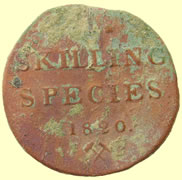 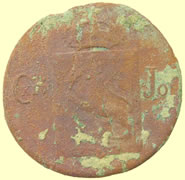 |
||||||||||||||
1838 Victorian milled silver groat (4 pence) (27) |
1820 Dutch copper skilling coin |
||||||||||||||
 |
 |
  |
|||||||||||||
Medieval harness ring |
1550 -1650 buckle |
1634 Charles 1st hammered copper rose farthing |
|||||||||||||
 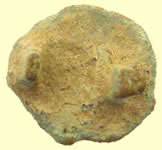 |
  |
||||||||||||||
16thC Tudor rose mount with 2 integral lugs |
16thC hammered silver 3 pence |
||||||||||||||
 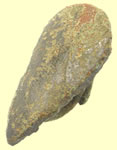 |
 |
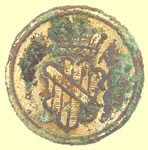 |
|||||||||||||
17thC mount with 2 integral lugs |
Post medieval strap or cord end |
19thC livery button |
|||||||||||||
  |
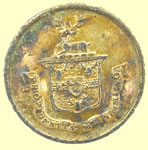 |
 |
|||||||||||||
1865 East India Company 1 Anna India coin |
19thC livery button |
20th lead toy soldier |
|||||||||||||
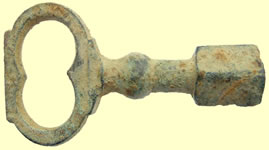 |
 |
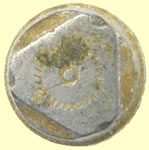 |
|||||||||||||
Georgian clock key |
|
Unusual 19thC silver button |
|||||||||||||
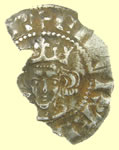 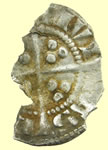 |
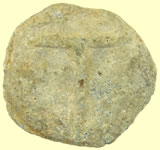 |
 |
|||||||||||||
1272 Edward 1st hammerd silver penny- Cross Potent Obv EDWAR AN ***** HYB Rev CIVI/TAS/** Possible Duram mint |
17thC lead navy token |
Musket balls Casting Sprue |
|||||||||||||
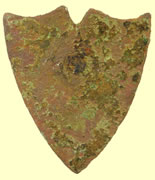 |
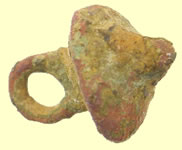 |
 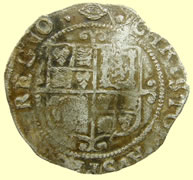 |
|||||||||||||
Georgian harness shield mount |
Early 17thC nipple button |
1634 Charles 1st hammered silver six pence |
|||||||||||||
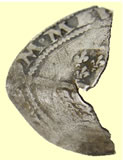  |
  |
||||||||||||||
16thC Elizabeth 1st hammered silver 3 pence |
1604-19 James 1st hammered silver half groat |
||||||||||||||
 |
|||||||||||||||
